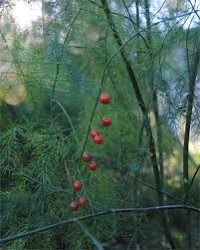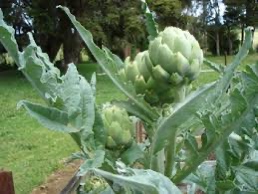 |
| Daffodils in bloom in the edible garden |
Sunday, February 29, 2020
Feels like spring is getting close! The hyacinths and daylilies are sprouting with daffodil flowers and forsythia in bloom. Now is the time to test your soil, get your garden beds ready for planting, and finish the plan for your spring garden.
Soil Preparation
You can take a soil sample to our local county co-op extension office to have it tested or buy a do it yourself kit at any big box store or local nursery. You can do a more extensive soil test by sending your soil sample off. Here is a link to my blog on soil nutrition: The next step in garden production and your nutrit... There is a great analysis web site that will provide a specialized fertilizer designed just for your garden deficiencies that you can make yourself. Well fed plants grow better and are more nutritious for you, too. A win-win.
If you don’t want to go to the trouble of testing, a sure way to enrich your soil is to use a balanced organic fertilizer and compost. I add organic material every spring with a layer of compost and hardwood mulch in the garden beds, building the soil’s fertility and its ability to hold water.
A local CSA farmer and organic gardener told me a few years ago that it is important to not let your fertilizer just lay on top of the ground as many of the nutrients will be lost, especially nitrogen. My spring routine is always to put down an organic fertilizer by Espoma, then a layer of homemade compost with any additional composted horse manure needed and top with mulch. Nitrogen oxidizes easily with the air so be sure to cover your fertilizer with soil, compost or mulch every time you fertilize. You can make your own balanced fertilizer, too, which is pretty inexpensive Make your own all natural, complete fertilizer
Ideas of what to plant in March:
There are already plants available at the big box stores in our area. This is a good and easy way to look for what will grow well in your area. The types that are already out there are cabbage, spinach, lettuce, onion sets, potato sets, blueberry, raspberry, and blackberry bare root plants. Wait until the soil has dried out somewhat if you are getting the amount of rai we are this year before planting potatoes or they could just rot. Time to plant potatoes, even if you only have a patio
I'm not planting any crops from the cabbage, broccoli and cauliflower this year to reduce the pest problems I have been seeing with these crops in my garden. Cabbage is nutritious and easy to grow Broccoli and cauliflower growing tips I say that every year, but I have a hard time resisting sprouting broccoli. It gives small broccoli florets and broccoli tasting leaves for salads spring, summer and fall. Sprouting broccoli- a year round fav
The greens I will plant in our mini greenhouse to keep them warmer that helps encourage growth so we get fresh salads as soon as possible. I just love spring salads!
 |
| Mid March garden |
Green Oakleaf Lettuce-ready to harvest in 45 days Everything you need to know about growing lettuce
Wild Garden Kales-ready to harvest in 30 days Grow one of the super greens this year-kale
Mesclun Valentine Lettuce mix (red tinted lettuce and greens)-ready to harvest in 30-55 days
Marvel of Four Seasons Butterhead Lettuce (I love the sweet taste of butterheads)-ready to harvest in 55 days Everything you need to know about growing lettuce
Red Sails Lettuce (a ruffled red and green, stays sweet even after bolting)-ready to harvest in 45 days
Red Sails Lettuce (a ruffled red and green, stays sweet even after bolting)-ready to harvest in 45 days
Space Hybrid Spinach-ready to harvest in 38 days Grow spinach-a super nutritious, easy green
Gourmet Blend Lettuce (Prizeleaf, Royal Oak Leaf, Salad Bowl, Ashley)-ready to harvest in 45 days
Sugar snap peas-ready to harvest in 70 days Time to plant peas!
All kinds of broccoli or cauliflower-ready to harvest in 50-80 days (leaves are great in salads) Broccoli and cauliflower growing tips
Cabbage-ready to harvest in 68 days. Cabbage is nutritious and easy to grow
Carrots-ready to harvest in 50-75 days Grow crunchy, colorful carrots practically year round
Parsley-70 days to harvest
Potatoes-ready to begin harvest in 70 days Time to plant potatoes, even if you only have a patio
The above can be companion planted with radishes, beets, chives, garlic, and onions. Since they are shallow rooted, they grow well with root crops. Get the most from your space-plant intensively!
When I plant in pots, I plant with a handful of worm compost and water in with fish emulsion. Germination should take anywhere from 4-15 days., depending on how warm the soil is. I am sure I will be out there looking for little green shoots daily. Decorative container gardening for edibles
Important tip-if planting seeds in a mulched bed, be sure to cover the seed with only soil; seedlings are too weak to push through mulch. Weed free, self fertilizing, till free garden beds
 |
| Potato box |
Zone 6/7 Spring Garden Roadmap
Planting your seedlings outdoors:
Now (or as soon as the soil can be worked)-fruit trees and vines, nut trees, asparagus, garlic, peas
End March-cabbage, leeks, lettuce, okra, onions, mustards, spinach
Beginning of April-lettuce, lemon balm, parsley
Mid-April-broccoli, cauliflower, thyme
End April-sage
First of May-basil, chives, cucumbers, tomatoes
Mid-May-cantaloupe, eggplant, marigolds, pepper
Starting your seeds outdoors**:
Now (or as soon as the soil can be worked): peas, spinach, lettuce
Mid-March: arugula, bok choy, cabbage, carrot, collards, leeks, lettuce, mache, onion. rhubarb, cultivated dandelions, spinach
End March: fava beans, beets, broccoli, carrot, Chinese cabbage, cress, kale, kohlrabi, leek, mizuna, parsley, parsnip, early potatoes, turnip
**One watch out is planting seeds too soon. Seeds have to have a certain soil temperature to sprout. Plant too soon and the seed will rot and not sprout. Here are some soil temp guidelines. Temps to plant seeds outdoors
Starting your seeds indoors for summer planting:
Now-chives, leeks, lemon balm, onions, parsley, sage, thyme, lettuce, cress, mustard, chard, spinach
Mid-March-basil, broccoli, cabbage, cauliflower, okra, marigolds, eggplant
End of March-cantaloupe, cucumber, lettuce, peppers, tomatoes
These dates are just guidelines. You can start your seedlings later and plant your transplants later as well. Be sure to read the seed packet for what you are starting. They make all kinds of varieties that are cold hardy and can be planted sooner than what I outlined above. If you get a cold snap, there are things you can do to protect your early crops. Extend the season with protection for plants
The big box stores and local nurseries are good sources of plants too. If you are just getting started, purchasing from a local nursery or farmers market will get you started with varieties that do well in your area.
The big box stores and local nurseries are good sources of plants too. If you are just getting started, purchasing from a local nursery or farmers market will get you started with varieties that do well in your area.
Happy gardening!




















